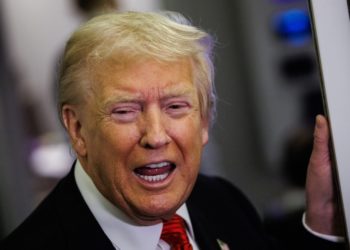The United States is currently in the midst of a grand experiment: what happens if we give the cranks, the maniacs, the grifters, the late-night AM radio conspiracy theorist call-in people the reins of the country? What happens if we hand over the government to the tinfoil hat wearers who have spent centuries thinking the government and its various nefarious plots are behind every evil deed?
It doesn’t seem to be going too well, but success or failure isn’t really the point when it comes to this kind of person. The point is the perpetuation of the mystery. The conspiracy itself, the community that builds around it, is the point.
In a new essay in MIT Technology Review, author Dorian Lynskey writes about the United States as a nation that thrives on paranoia and conspiracy, and how technology has only made it easier to get lost in your own little parallel world of unreality.
Lynskey writes about a pair of mid-century scholars whose works combined to divide the roadmap for understanding modern conspiracy theory culture. Karl Popper, a Philosopher who defined the idea of a conspiracy theory as we know it today, and Richard Hofstadter, a professor of American history at Columbia University, who gave a lecture on the paranoia inherent in American politics the day before President John F. Kennedy was assassinated, kicking off one of the most enduring conspiracies in American history.
Together, they nailed something that still defines our public life: the idea that if we just dig deep enough, we’ll find the puppet master pulling every string.
The problem here, Lynskey argues, is that this idea is nothing new. It’s been around for centuries. The only thing that changes is the names of the people behind it all. In the 1700s, it was the Illuminati. In the 1800s, the Jews of The Protocols of the Elders of Zion. In the 1900s, the communists. In the 2000s, it was globalists, George Soros, or “The Deep State.”
Each set of villains provides the same thing: a tidy explanation for why things are a mess, and they give the paranoid someone to blame it all on. Conspiracy theories don’t just invent villains; they recycle them.
Technology supercharges it all – and not just of the smartphones in our pockets. Lynskey says the printing press fueled witch hunts, and radio helped spread fascist propaganda. All smartphones and the internet have done is turn paranoia into a lifestyle brand. Algorithms run on outrage, and the people on these services demand simple, elegant answers to deeply complex problems, but don’t realize that the supposedly simpler and more elegant solutions are much more complicated than anything reality has to offer.
People today can fully envelop themselves within conspiracy theories much more easily than people ever could before. You could, in no time at all, almost accidentally curate a social media feed that walls off reality and nestles you within a cozy little cocoon of conspiracy.
Hofstadter warned that the paranoid style thrives when people feel powerless. Today, we’re drowning in powerlessness. NPR just ran a demoralizing story about how America’s youth feel like they have no future, that the American dream is well and truly dead, and no one in charge cares enough to do anything about it.
That is probably why we are currently being run by the conspiracy theory administration. In an era where hope is dead, anyone with a social media account can rise up and provide “truths” that easily and conveniently explain who’s behind the latest crisis, only for all of that to get tossed out and replaced with a whole new set of villains when the next outrage hits.
Lynskey stops short of really digging into why conspiracy theories persist, especially in this day and age when they seem more prevalent and influential than ever. I have my own theory about that.
Conspiracy theories used to exist on the political fringes, but now they are the establishment. Conspiracy theory is now policy. This is what happens when you create a large-scale societal shift in focus away from those of us who feel powerless and start catering to the powerful. In time, this shift drives a society toward trying to find a collective explanation for why the majority was abandoned.
There were no simple answers. The divide-and-conquer strategies of American politics muddied the waters. Everyone could potentially be corrupt. Everyone could potentially be a part of the problem. All the while, being ignored and being driven into isolation drove us crazy. It broke our brains. Sometimes, a large-scale societal shift in focus away from those of us who feel powerless and a catering toward the powerful can, in time, drive a society toward blaming a shadowy network of powerful figures when, really, the problem is just as simple as neglect.
The post It’s Never Been a Better Time to Be a Paranoid Conspiracy Theorist appeared first on VICE.




